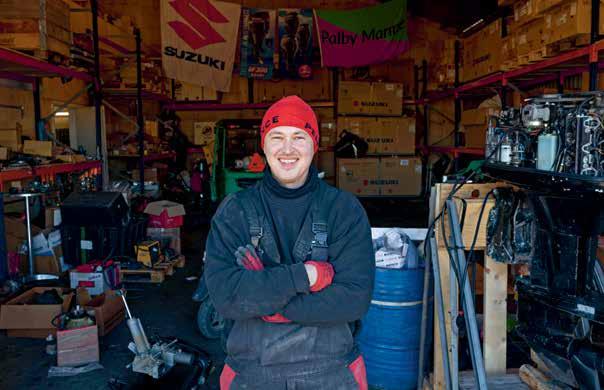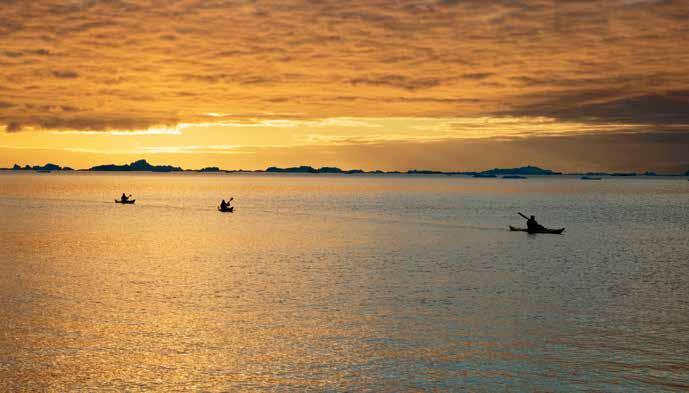
10 minute read
The hotel director
THE MECHANIC
Jesper Sandgreen, a mechanic with Ilulissat Marine Service
There are not many cars in Ilulissat. Instead, there are hundreds of dinghies and boats, so Jesper Sandgreen has made the switch from car mechanic to boat mechanic. When Jesper Sandgreen moved back to Ilulissat after spending nine years in Denmark, the first thing he did was to drink a big glass of water. ‘And then I breathed in the air from the Icefjord. It was just amazing to be back in Ilulissat. The air is different; the water tastes different. Much more fresh and clean,’ says Jesper, who is a trained car mechanic. He had no hesitation when Ilulissat Marine Service rang him in Denmark to hear if he might be interested in returning home and working for them. His girlfriend, who is a mechanical engineer, was also keen to go, and today the couple live with their two children in a house in the middle of town. Once again close to family and friends. ‘There aren’t many cars in Ilulissat, so now I’m a boat mechanic instead of a car mechanic. This means I am learning a lot and expanding my professional skill set, which improves my options, also in the long run,’ says Jesper, as he gazes out over the sea ice.
‘That’s bound to put a smile on your face, wouldn’t you say?’ he says. Back in Denmark, he found less reason to smile. He also had less time for family life in the city. He had a half-hour commute to work and did not get off early enough to pick up his children from day care. All in all, this way of life was sapping his spirit and his energy. ‘I was becoming increasingly pent-up and unhappy about my situation. That, too, convinced me that coming home was the right choice. Now everything is within walking distance, I can pick up my kids, I’m close to nature and the people I care most about. In fact, I don’t even own a car any more because I can walk everywhere. And people in Ilulissat are so friendly, always waving hello to each other, so much so that your arm gets tired with all the waving,’ he says with a big smile. This warm and welcoming community is one of the things Jesper hopes the tourists will experience too. And he has no doubt that the Icefjord Centre is going to draw more visitors to the area. Something he looks forward to. ‘I would love to show off my town; there is so much to see and experience here. An increase in tourism might also convince more people to return home, as we have done. That would be great. The more, the merrier,’ says the mechanic.
Jesper Sandgreen is happy that he chose to return to Ilulissat. He hopes that the tourists, too, will sense the warm and welcoming spirit of the town.

THE QAJAQ CHAIRWOMAN
Pia Jensen, chairwoman of Qajaq Ilulissat

Pia Jensen learned to qajaq as a child. Now she is teaching the techniques to her son, and in her spare time she coaches children and young people from Ilulissat. At the top of one of the mountains in Ilulissat there is a little, blue house. Overlooking the red-and-white hospital, the black church, the local houses and, not least, Disko Bay and the icebergs. The house is the home of Pia Jensen and her boyfriend, Karl Peter, their three-year-old son, Knud, and the family’s best friend, Kaspaaraq. But family life only takes up part of her day. She is also the passionate chairwoman of the local qajaq club, which numbers fifty active members. While most of the world knows a kayak as a small, narrow boat made of fibreglass, carbon fibre or plastic, a Greenlandic qajaq is traditionally constructed of wood and canvas. For generations, this boat type has been an essential tool for Inuit hunters in Greenland and Arctic North America. Today, it is mainly used for sport and play. ‘I was virtually raised in a qajaq. My father told me to watch what he did, and that was how he taught me to sail. I don’t recall whether I found it easy or hard, but I participated in my first competition at the age of three, in Paamiut. Now I am teaching my own son, but I think my approach is a little different,’ says Pia, laughing. In addition to training her own son, she also trains other qajaq enthusiasts, mainly children aged 4 to 16 years. The club is seeing a renewed interest, especially from children, and she puts a great deal of effort into the training, which takes place on the water during most of the summer. ‘In the qajaq, we have to make the most of the brief summer. During the winter, we focus more on training strength, endurance and balance on two suspended
ropes,’ says Pia, who puts great emphasis on teaching the young prospects to have respect for the icebergs. A respect the experienced rower shares. ‘I don’t like to get too close, because we never know when they are going to roll. And when that happens, human beings are tiny in comparison to the giant icebergs.’ The wall in the living room is decorated with medals from the many qajaq competitions that the Jensen family, including her parents and siblings, have participated in. From Uummannaq, some 200 kilometres north of Ilulissat, to Nanortalik in the southernmost part of Greenland. Every year, clubs from all over the country meet to compete in the Greenlandic qajaq championship. ‘Next year, the championship takes place in Ilulissat, so as chairwoman, I am busy,’ says Pia, as she walks down the steep stairs from the mountain with the blue house to the qajaq club house in Kirkebugten (Church Bay). Winter time is also a time for maintaining the qajaqs and building new ones. This is done in accordance with the ancient traditions that Pia also learnt from her father. ‘I can’t build a qajaq myself, but I know how it’s done. I have seen my father do it so many times that it’s like having a film in my mind. That enables me to instruct others and tell them exactly what to do,’ she explains. When Her Majesty Queen Margrethe visited Ilulissat in October 2021, Pia was invited to the kaffemik – coffee party – at the Icefjord Centre in her capacity as chairwoman. When she learnt that she would be seated at the Queen’s table, the normally calm qajaq woman felt a little jittery. ‘But it worked out okay, and it was a great experience. I am happy to represent the qajaq, which means so much and is such a big part of my life. And the Queen was very interested. I think she was surprised that we use the traditional qajaq and not the plastic kayak,’ says Pia.

The Greenlandic qajaq was previously an essential piece of hunting equipment for Greenlandic Inuit. Today it is mainly used for sport and play or for pleasant trips under the setting sun.
THE HOTEL DIRECTOR
Anders Okholm Gadeberg, managing director of Hotel Icefiord

From the restaurant at Hotel Icefiord, the guests and the hotel director have an exceptional view of Disko Bay and the large and small icebergs gliding by on their way from the Icefjord to the sea. The view from the picture window in the restaurant at Hotel Icefiord is almost indescribable. The hotel is literally on the edge of Disko Bay, and just outside the window large and small icebergs glide by on their journey from the head of the fjord to the sea. For the tourists, the sight is an experience of a lifetime. For the two local hunters sitting at one of the tables, it is commonplace in everyday life – if a view such as this can ever become common. The two hunters are at the hotel to deliver 350 kilos of musk ox meat to the hotel’s managing director, Anders Okholm Gadeberg, who is about to meet them to pay for the delivery. That is just one of his many diverse tasks. ‘To me, everyday life at the hotel is a little bit like being out on the water in the Icefjord, where you have to navigate sheet ice, ice floes and large icebergs. You never travel in a straight line from point A to point B when you’re out there. First you have to navigate around all the ice and decide whether to tack this way or that. Is
the other way better, or did we just manage to squeeze by? That’s not a bad metaphor for the job of managing a hotel here in Ilulissat,’ says Anders. The young director’s journey began with a thirst for adventure. At the age of 24, he signed up for a tour guide course, which led to a job as a tour guide in Ilulissat. He was offered the position as managing director of the hotel just as he had decided to return to Denmark to finish his studies. ‘I literally had to get my head underwater a few times,’ says Anders, whose main hobby is wakeboarding. A passion he has taken with him to Ilulissat and now pursues in the fjord during the summer. Eventually, he accepted the job, and in December 2018 the newly appointed director left family, friends and acquaintances behind in favour of a life in Greenland, which he had only seen a small fraction of at the time. Anders soon discovered that the Arctic is very different from Europe. He had barely taken up his new position before there was a break in the undersea cable connecting North Greenland to the rest of the world and securing a reasonable internet speed. ‘Suddenly, we had hardly any contact with the outside world. Our guests could not go online, and we could not communicate with guests who were planning to visit. We had to get up at three in the morning to send emails. For months, Greenland was connected to the rest of the world via a radio chain, which made the internet connection really sluggish. At that point I truly realized I was a long way from home and from everything I had taken for granted,’ says Anders. The hotel director also had to get used to living in a small community, for better and worse. On the plus side, everybody greets and knows each other; on the down side, there is also no way to avoid someone you might not get along with. Or employees you had to let go. None of these challenges caused Anders to lose heart. On the contrary. Over the past few years, he has developed a range of new experiences for tourists in the town. He has a particular interest in possible gastronomic experiences for tourists and locals alike. ‘We have a unique opportunity to go all in on “field to table” with the culinary resources all around us. Mussels, seaweed, musk ox and a wealth of other ingredients. Sea urchins are a new thing, which we recently tried for the first time,’ he says. As tourism provides the economic basis for the fifty-one rooms at Hotel Icefiord, the director is happy about the Icefjord Centre, which he sees as one more part of the total package needed to attract more visitors. ‘None of us can stand alone. Of course, the Icefjord is the reason why people come here, but without good accommodation, good food and, now, the stunning Icefjord Centre, where they can learn about the area, the visitor numbers would drop, and that would change life in Ilulissat,’ says Anders.

Hotel director Anders Okholm Gadeberg has his own personal favourite spot for taking in the view of the Ilulissat Icefjord. This area is also where some of the ingredients for the hotel kitchen are sourced.
















